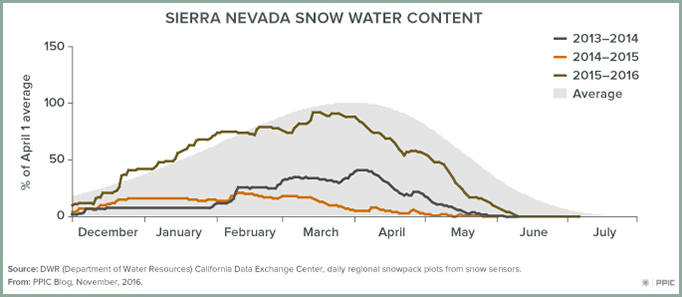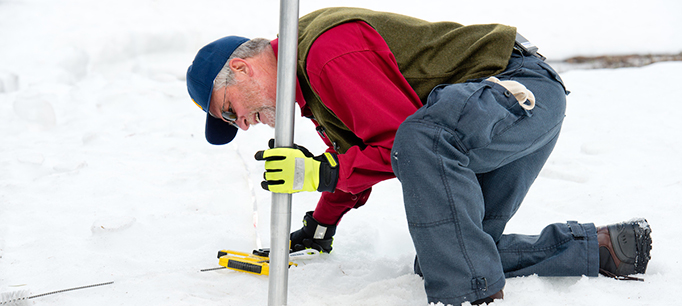Snow—or the lack of it—has been making headlines lately. California has had unusually low snowpack for the past several years, and the winter of 2015 was the all-time lowest snowpack in recorded history. Low snowpack brought major challenges to water managers.
Snow plays a disproportionately large role in water and environmental management in California. About a third of our average annual water supply starts out as snow. It flows into our major reservoirs in spring and early summer, when water demand on farms starts to ramp up.
“Snow droughts” typically coincide with reduced overall precipitation. This is always associated with a reduced number of large storms during winter (California relies on a handful of large storms every year to supply most of its water.) Snow droughts are also associated with unusually warm conditions.
Temperature affects snowpack in several ways. During warm winters, rain turns to snow at higher elevations than in colder years. This means that a smaller area is covered by snow, and there is less snowpack. Snow—like water—can also evaporate when conditions are warm. This process, known as sublimation, can dramatically reduce the snowpack. Finally, warm conditions cause early melting of the snowpack. The thinner the snowpack and the warmer the conditions, the sooner it will melt. In an average year, California’s snowpack starts to melt around April 1. During warm drought years, it can melt as much as a month or more earlier.
A good snowpack helps bolster our reservoirs precisely when the demand for water—principally for irrigation for farms—is highest. Many reservoirs are required to maintain space for capturing winter floods to protect downstream users. The spring snowmelt is critical for refilling these reservoirs to meet water supply needs. Snow droughts add special challenges to water management because changes in the timing and volume of runoff can have a big impact on reservoirs.
Environmental management is also complicated by snow droughts. State and federal laws require that many reservoir operators release cold water to support downstream habitat for steelhead and salmon. During the warm days of summer, managers tap into the pool of cold water that accumulates at the bottom of a reservoir (cold water is denser, so it sinks). Snowmelt runoff lowers the temperature and increases the volume of a reservoir’s cold water pool. This gives greater flexibility to managers for meeting both water supply and habitat needs, which are often in competition.
Snowpack is also the source of most of the state’s hydropower generation. A small or early snowmelt can cause significant reductions in hydropower, forcing utilities to make up the difference with other sources (most typically, fossil fuels).
Finally, snow droughts may be increasing in frequency and intensity. Recent studies throughout the West are showing that temperature—rather than reductions in precipitation—may have the most significant influence on drought conditions. And most climate projections suggest that this trend will likely worsen over the course of this century. The 2012–15 snow drought—along with all its water management challenges—may become much more common in the future.
There are no simple solutions to the loss of snowpack. To adapt, California will have to shift from its historic reliance on snowpack for storing water. This will require more flexible operation of our surface reservoirs to accommodate changes in timing and volume of snowmelt runoff. We’ll have to shift more water into aquifers to support flexible operation of dams, particularly those that need to make space to capture winter floods. And environmental managers will have to find innovative ways to conserve cold water to sustain salmon and steelhead populations, especially as the climate warms.
All of these adaptations are doable and need not represent major increases in costs or disruptions to water supplies. But we’ll need new policies, changes in the traditional ways we manage water, and a willingness to act to address the snow drought challenge.

Read California’s Water: Climate Change and Water (from the California’s Water briefing kit, October 2016)
Watch “California’s Water Challenges: Water Supply”
Visit the PPIC Water Policy Center drought resource page


